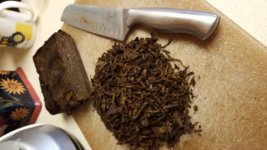Breaking News!
[
The images below are graphic. Some readers may find them disturbing.]
At least the discovery of this booboo was a dramatic moment. Just last night, I checked the clamp press holding my small batch of Perique, now about a month old, which has been resting on the floor of my enclosed back porch. It looked happy. Today this:
The plastic jar, which I originally took to be Lexan (polycarbonate), is definitely the lower strength plastic, acrylic. While Lexan is bulletproof, acrylic is a more ordinary plastic.
Although I've used this jar, as well as a taller version of the same thing (each purchased for less than $10 at Walmart) for a number of years now, this one unlucky batch cracked the jar. Why? I think I know.
The clamp that I use (shown in the first post of this thread), is somewhat difficult to tighten, since the turning handle is a simple, smooth, wooden cylinder. It's hard to get a firm grip on it. Before starting this latest batch, I noticed that the threads of the clamp were exhibiting signs of wear. Being a clever guy, I sprayed the threads with non-stick cooking spray (with heart-healthy Canola!). This significantly reduced the friction of turning the screw when there was axial pressure against it. What could go wrong?
With my newly acquired super-hero clamping ability, I tightened the clamp about every other day, twisting it with roughly the same grip force that I've always used for it. In retrospect, it is not surprising that I clamped it way too tight--the result of my heart-healthy cooking spray on the threads.
So I said a fond farewell to my short
acrylic jar, and transferred the now juice-less tobacco to the taller jar that I had originally used. I added some water, then clamped it down with more restraint.
Since this batch is Habano Colorado, I was expecting it to be stronger than previous batches. Now that its life blood has been spilled, I suppose it will be rather ordinary, once it's done in two more months.
If I truly believe my notion that the leaf really needs to be firmly pressed only once, to disrupt the cells, then gentler pressure (along with a liquid seal) should be sufficient for the remainder of the run. We'll see. (The dominant
Pithia yeast may take a while to readjust the pH.)
Bob
EDIT: Cleaning up the mess is fairly easy. A simple Clorox-containing kitchen cleaning spray quickly zaps the sticky goo, and bleaches the color.












